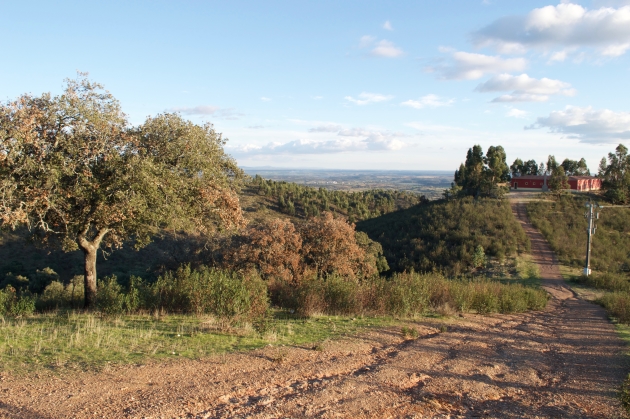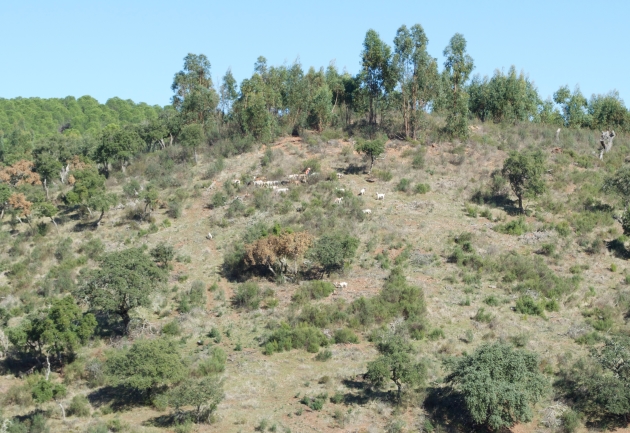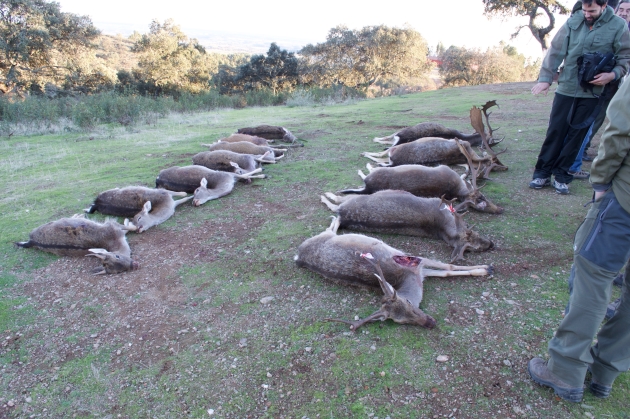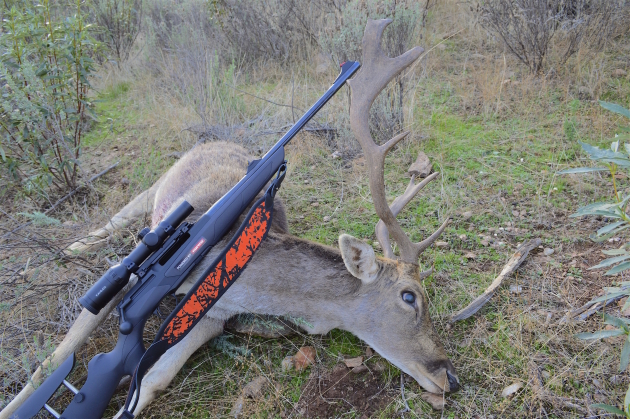After sighting in our guns, we drove an hour and a half east to the city of Évora. We were hunting with Mancho Maior, a hunting organization and one of the last providers of the traditional Portuguese monteria. Since our two-day hunt would be spread out over 20 kilometers or so farther to the east along the border with Spain, we stayed in a centrally located hotel.
Our host, Mancho Maior’s Paulo Pereira, gave us a detailed rundown of what to expect on the next morning’s hunt. We could each shoot one buck and one doe, either fallow or red deer, as well as all the wild boar we wanted. Our first day’s hunt was primarily deer habitat and the second day’s boar, but anything could pop up at any time.
A monteria is far more than an Old World cousin of the American dog drive. The European version employs impossibly large numbers of dogs—our drive used 250—for a group of hunters numbering in the 80s. While we writers totaled a measly 20 or so by comparison, we would be treated to the same number of dogs in order to experience the full monteria effect.
We would be stationed at various stands spread across 300 hectares. Each hunter was placed on a hillside shooting across a valley and into another hillside, guaranteeing we wouldn’t shoot at the same animal . . . or each other. The dogs would then course through the valleys and along the ridges, pushing game past us as they went.
I was dropped off at my designated position around 10 a.m. the next morning. (No need to wake up early when the hunt doesn’t start until the dogs are turned loose.) Even though the hunt wouldn’t officially begin until all the hunters were ready and the dogs had been turned out of their kennels, I came face to face with big game as soon as my feet touched earth. Two fallow deer does were making their way along the river bed below me, and a spindly fallow deer buck was walking in and out of the shade of a tree some 150 yards away. While I did train my scope on him for the sake of practice and habit, I decided not to fire. I was there for a monteria; I would wait for the dogs.

Monteria country is beautiful country. The hills of our hunting area drop quickly away to the flat plains of central Portugal.
You know precisely when a monteria begins, even when you’re far from the starting point. Between the bells attached to some of the dogs’ collars, the yipping of the animals themselves, and the near-constant “Hey. Hey! Hey!” of the handlers as they strive to keep the dogs moving straight ahead, the approaching drive is unmistakeable.
The game animals begin moving long before the dogs reach them. Boars will often lie in thick cover, waiting for the dogs to either pass by or come close enough for a brawl, but the red and fallow deer take to the hoof as soon as they realize they’re being pursued. Such was the case with my three companion deer, gone almost as soon as the noise of the drive began carrying over the ridges and down the valleys.

Some of the dogs and their handler move across the hillside opposite the author’s position.
Deer began moving and hunters began firing. New to the monteria, I tried to pick my shots as carefully as possible. Shots at running deer are taboo in my native woods, so getting outside of that mindset and making the most accurate shots I could took some time.
I took a few shots at deer, all clean misses. While I was prepared for the deer to cross the hill I was facing, I didn’t expect so many to come within 30 yards of me, both below and above my stand. With my 1-5X scope turned to 5X for the longer shots, I had too much magnification for these unexpected close-ups. One fallow deer fawn, which I wouldn’t have shot anyway, ran out of the brush and right past me at five yards.
After an hour or so, I saw a nice fallow deer buck moving down into the valley to my left, maybe 125 yards away. In decidedly un-monteria fashion, I dropped with my butt to the ground and steadied for the shot. My first shot was too far forward, but the second shot drilled the animal’s heart.
My buck was down, but that still left me with an hour or so of drive time and a doe tag left to fill. It wasn’t long before three does came running right-to-left across the valley. The first and biggest doe was out in front, the two smaller ladies neck and neck 15 yards behind her.
I shot once at the first doe, offhand and standing this time, with no visible effect. The other two disappeared back over the hill.
I was pleased that I had at least missed cleanly when the deer disappeared into a clump of brush along the river bed. When/if she came back out, I never saw her.
I was 99 percent confident I had missed, but still, I didn’t want to make the mistake of shooting two does instead of my allotted one. As a result, I passed up a stupidly easy shot at another doe as she paraded by directly across from me, practically sashaying by as if she knew I wouldn’t shoot.
So ended Day One. The guides gradually came back to pick us up, transporting us to a nearby house for a cooked-on-site lunch. I made my way down to my buck shortly thereafter, snapping the photo seen at the top of this article. While in the valley I also searched for any signs of a hit on the doe, but thankfully she escaped unscathed.
Ending on a Peculiar Note
In traditional European fashion, the animals taken during the day were laid out in two lines for a special closing ceremony. I’ve seen pictures and read articles about this event, but until you’re actually there and playing a role in it, you can’t fully appreciate how important it is to the whole affair.
Four of us were seated in front of the animals: one, the “Hunt King,” for taking the biggest deer, one for taking an animal with the fewest shots, and two of us—one hunter from Poland, Lukasz, and myself—for participating in their first monteria.
They started with me, with Paulo giving a short speech about the momentous occasion and the right of passage I was about to undergo. For crossing the Atlantic and taking one of Europe’s deer, I was to be “baptized,” an unusual phrase that actually meant “taking a chaw of cud from the deer’s stomach and applying it to the hunter’s forehead.” I thought it was a joke at first, then I thought it was a form of hazing, then I thought the grass would be brought close to my head and then taken away in order to see my reaction.

At the end of the day, each hunter’s animal is respectfully laid out for a traditional European hunting ceremony.
No, no, and no. Paulo was lenient and applied the smallest possible amount of grass to my forehead, but I was indeed baptized. Immediately afterward he whispered to me that I could go wash off, which I did. When I returned Lukasz had blood smeared on his forehead, which I envied as the smell of semi-digested grass wafted down from my own.
It turns out that the standard ceremony is much more . . . elaborate. The typical initiation for a new hunter is to take all of the animal’s organs and craft them into a sort of hat for the novice to wear. Thankfully, my hosts decided to minimize the shock to their American visitor and tweak tradition just a bit. Thankfully!
With my first day of monteria behind me and the initiation over, I could look forward to the next day with a much better idea of what to expect.
Or so I thought . . .
Check back tomorrow for more from the Portuguese monteria.

